Water conservation and technical solutions

Date of implementation
1.9. – 19.12.2025
Scope
Type of studies and location
Which degree program is the course from?
Degree Programme in Energy and Environmental Technology
Teaching language
What will you learn?
The student knows what kind of policies and regulations direct water resources management in the Baltic Sea region. The student can identify pollution sources in a drainage basin, he/she knows the basics of integrated water resources management and can use GIS tools for planning of water protection measures.
The student knows the basics of water and habitat restoration methods and can make draft designs of different types of solutions for reducing diffuse loading. The student knows how official water quality monitoring works and how continuous monitoring methods can be used for assessing the efficiency of water protection measures.
What do the studies include?
– Ecological and chemical state of water bodies
– Different types, sources and impacts of loading into water bodies
– Integrated water resources management and the basics of River Basin Management planning
– The use of GIS (geographical information system) tools in water resources management
– River, stream and lake restoration methods
– Solutions for reducing nutrient and chemical loading from diffuse sources
– Planning and dimensioning of water protection measures
– Water quality monitoring
Course will be held between 2.9.2025 – xx.12.2025. The course will start on Tuesday 2.9.2025.
The course will be mainly held on campus.
Goals:
The student knows what kind of policies and regulations direct water resources management in the Baltic Sea region. The student can identify pollution sources in a drainage basin, he/she knows the basics of integrated water resources management and can use GIS tools for planning of water protection measures.
The student knows the basics of water and habitat restoration methods and can make draft designs of different types of solutions for reducing diffuse loading. The student knows how official water quality monitoring works and how continuous monitoring methods can be used for assessing the efficiency of water protection measures
Content:
– Ecological and chemical state of water bodies
– Different types, sources and impacts of loading into water bodies
– Integrated water resources management and the basics of River Basin Management planning
– The use of GIS (geographical information system) tools in water resources management
– River, stream and lake restoration methods
– Solutions for reducing nutrient and chemical loading from diffuse sources
– Planning and dimensioning of water protection measures
– Water quality and quantity monitoring
Course will have 7 individual parts/elements:
– Basics & Limnology, 2 credits
– Policies and co-operation, 1 credit
– Lake and River restoration, 1 credit
– Monitoring techniques and technologies, 1 credit
– GIS, 3 credits
– Load Reduction, 2 credits
– Integrative report, 1 credits
When and where will the course be held?
You can find the exact teaching times and places on Lukkarikone.
- Change the language from the top right corner under “FI”. Enter the course code 5100BI71-3005 and press search.
- Add the course to the schedule by pressing +Add on the search results list.
- The course schedule is now shown on the calendar view, where you'll find the time and place of each meeting.
If the teaching times are not shown on Lukkarikone, contact the teacher.
Enroll
for
the
course
Enrollment period
Study places
3
Price:
165 €
Who is the course suitable for?
Open UAS courses are open to everyone. Open UAS courses are selections from Bachelor’s and Master’s degree program curricula, and you’ll usually study in the same group as degree students.
When you enroll, you will be asked to authenticate yourself before you can access the enrolment form. You will need Finnish online banking credentials or a mobile certificate.
There may be prerequisites for participation on individual courses. You can find information on required previous studies or know-how in the course details on our study guide, see the link for course details above. Please note that you are responsible for making sure that you have the skills and know-how required for participation.
To participate on Master’s level courses, you must have completed a Bachelor’s degree or equivalent higher education degree in Finland or abroad.
Open UAS offers individual courses in both Finnish and in English. Please note that you must have sufficient language skills to take part in Open UAS studies. Generally, language skills at level B1 or above are recommended for participating in higher education. Some study options may have specific language skill requirements.
Open UAS study fee
Open UAS studies are subject to a study fee. Individual courses usually cost 15 € per ECTS credit. Read more about study fees.
If the study fee for a course differs, or if the course is free of charge, the information is available in the course information above.
5 reasons to study at Open UAS
- Open UAS studies are for everyone, regardless of age or background.
- You can try what’s it like to study at a UAS or get to know a study field you’re interested in.
- You can take individual courses or larger study modules.
- If you’re aiming for a Bachelor’s or Master’s degree, you can complete credits in advance.
- You’ll gain new skills, learn and be inspired.
Enjoy every person’s right to study. Learn more about Open studies.

